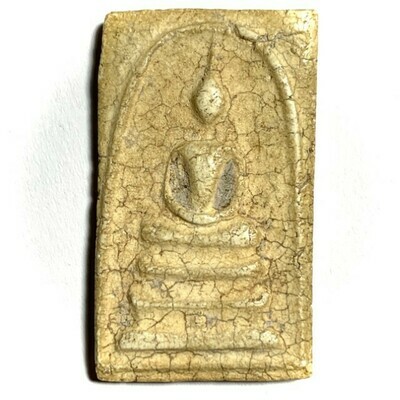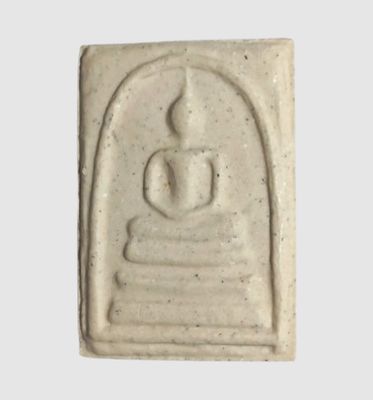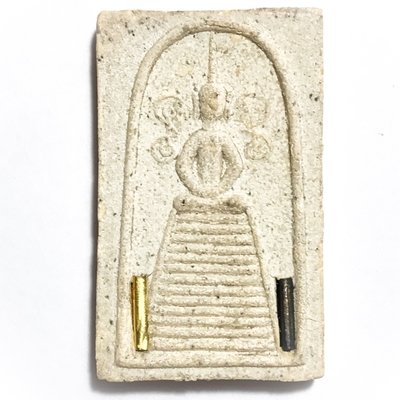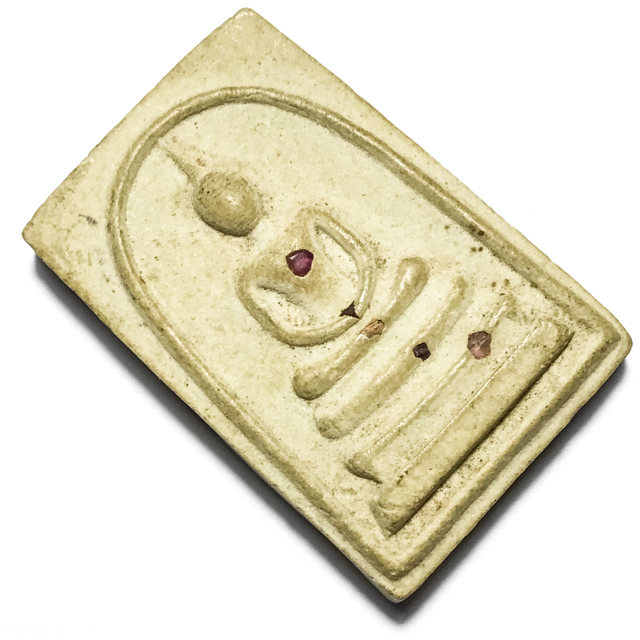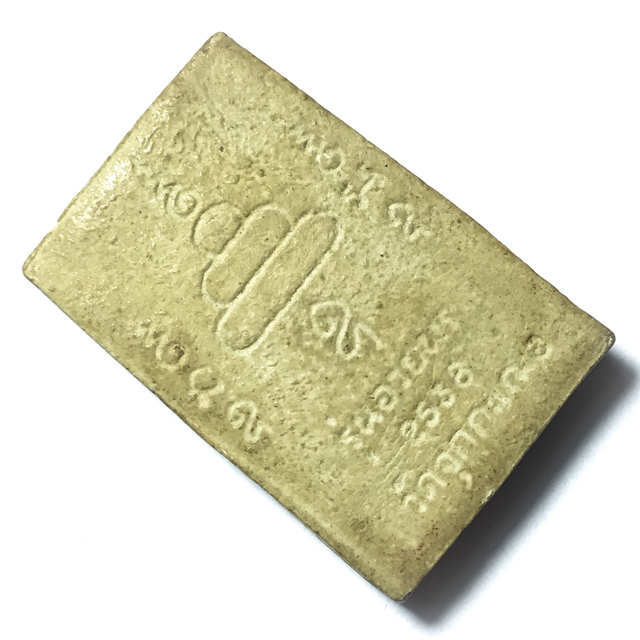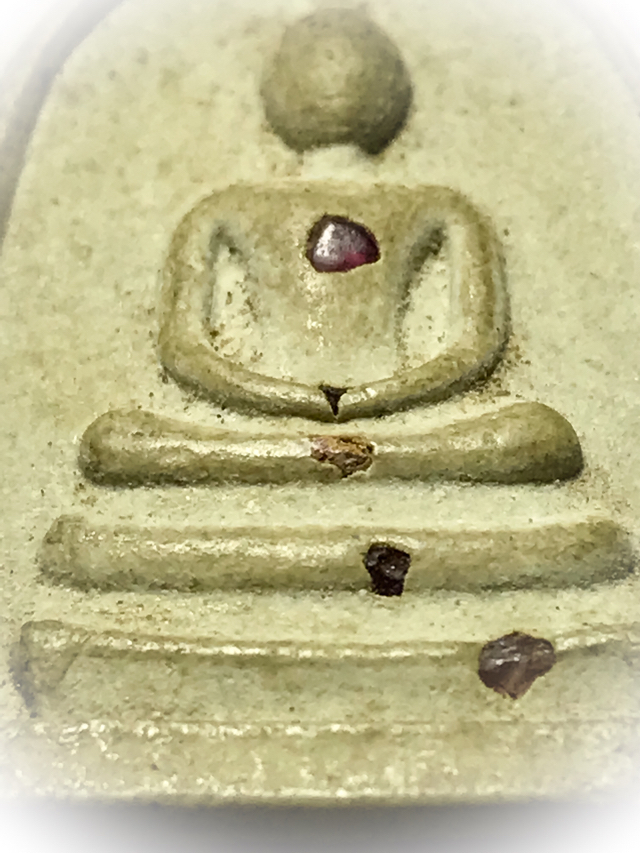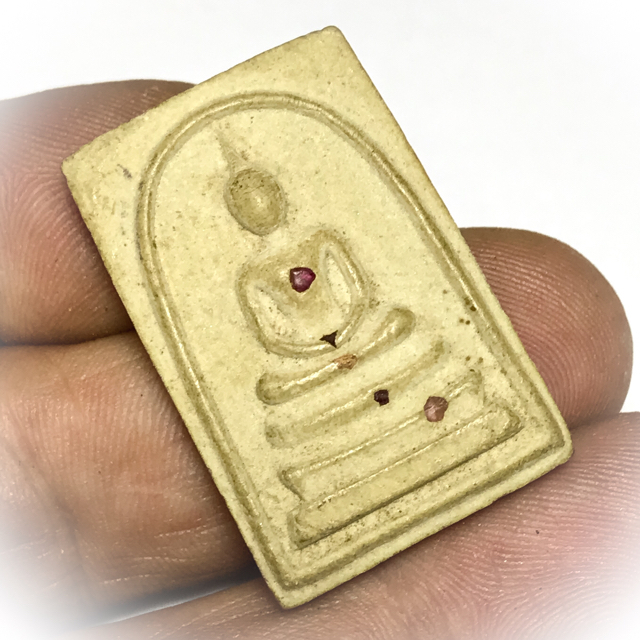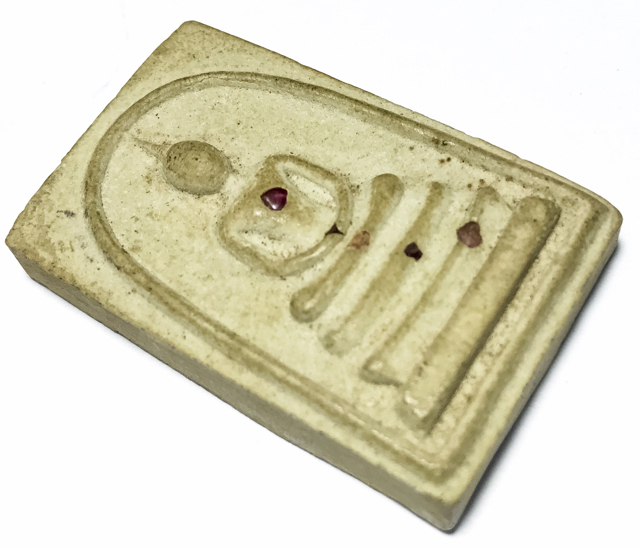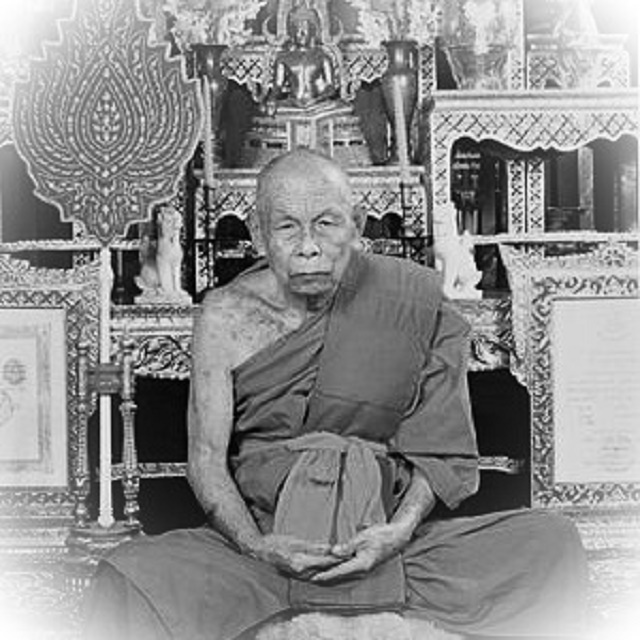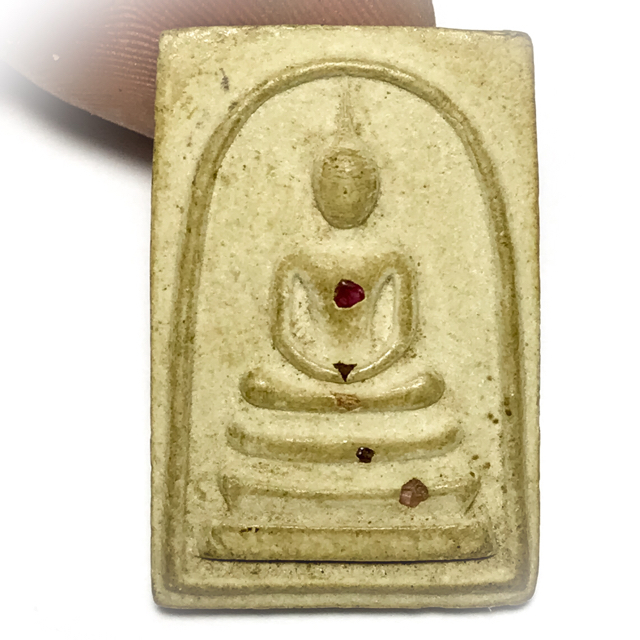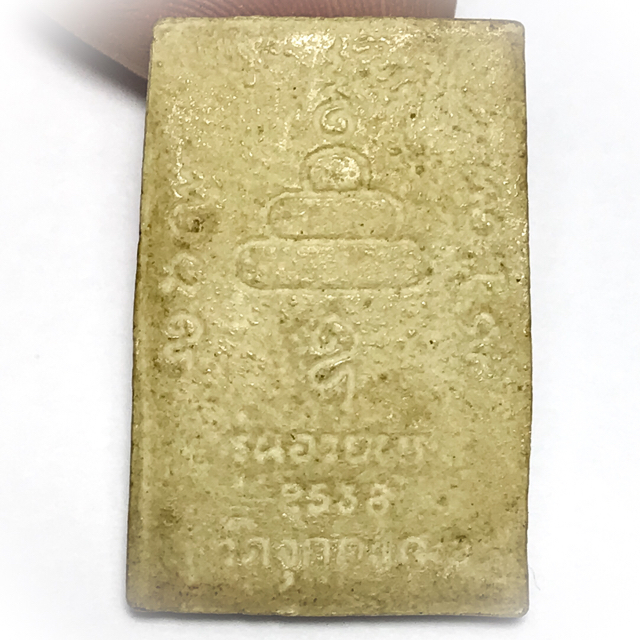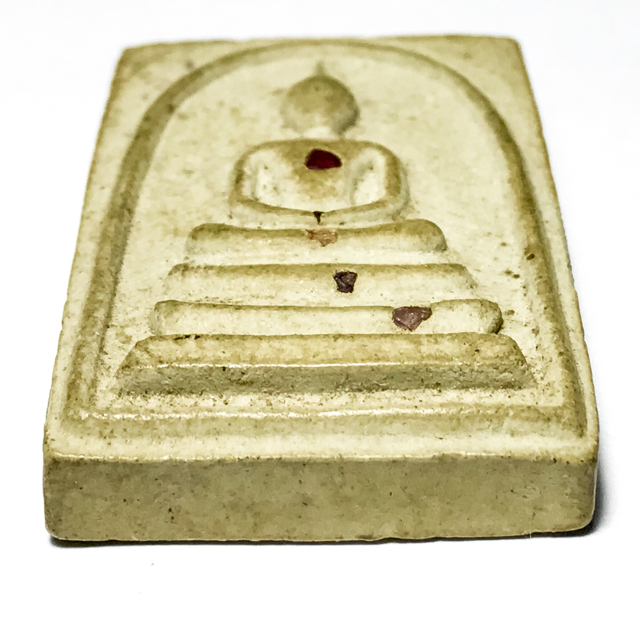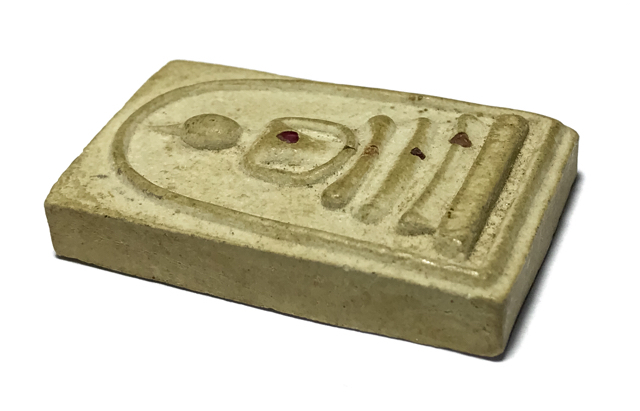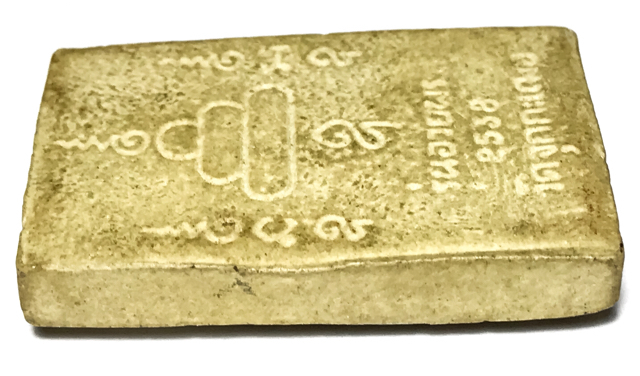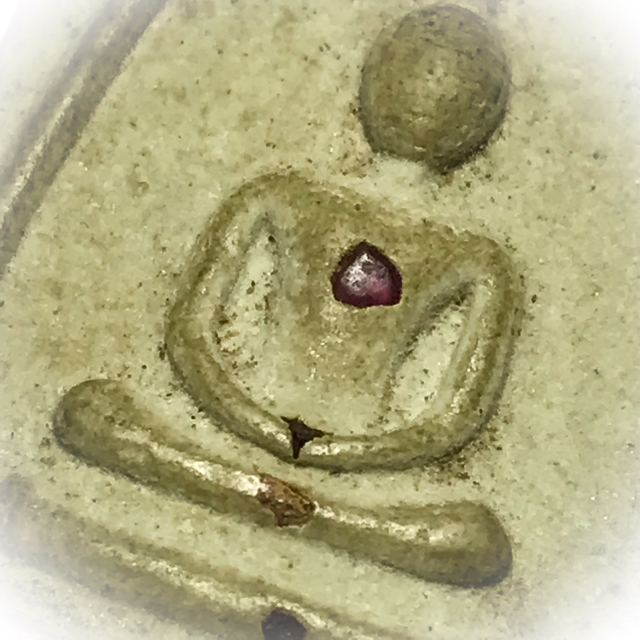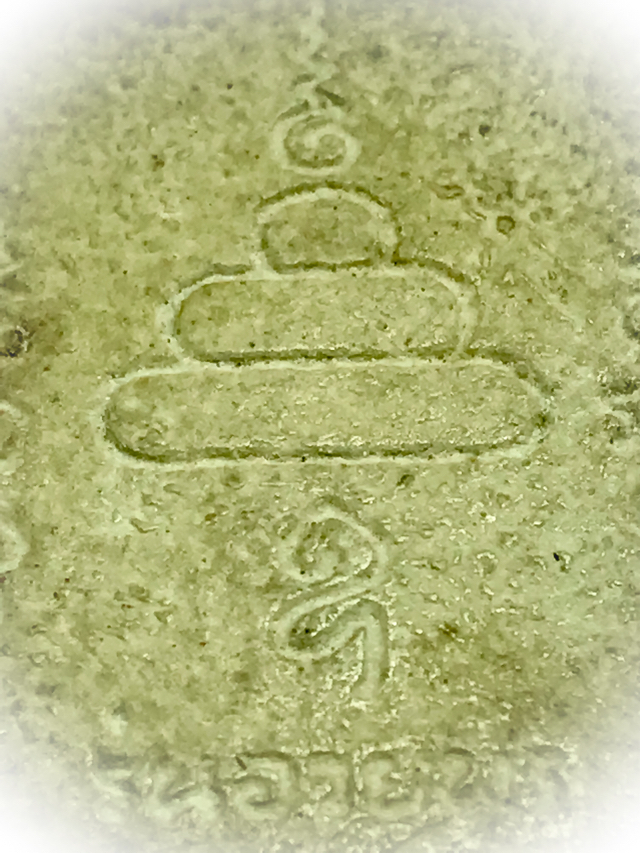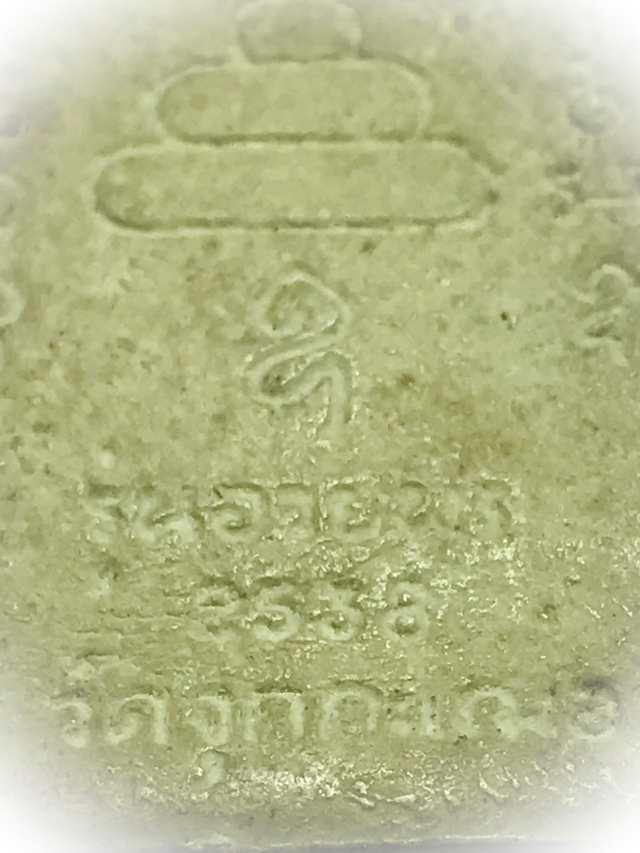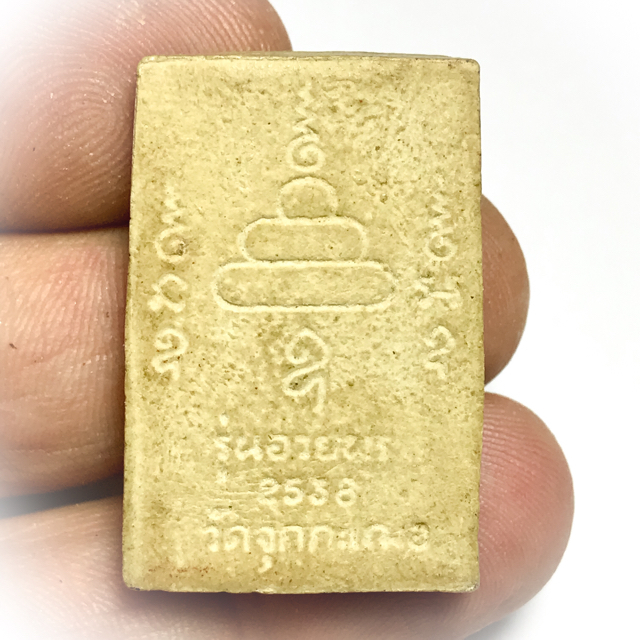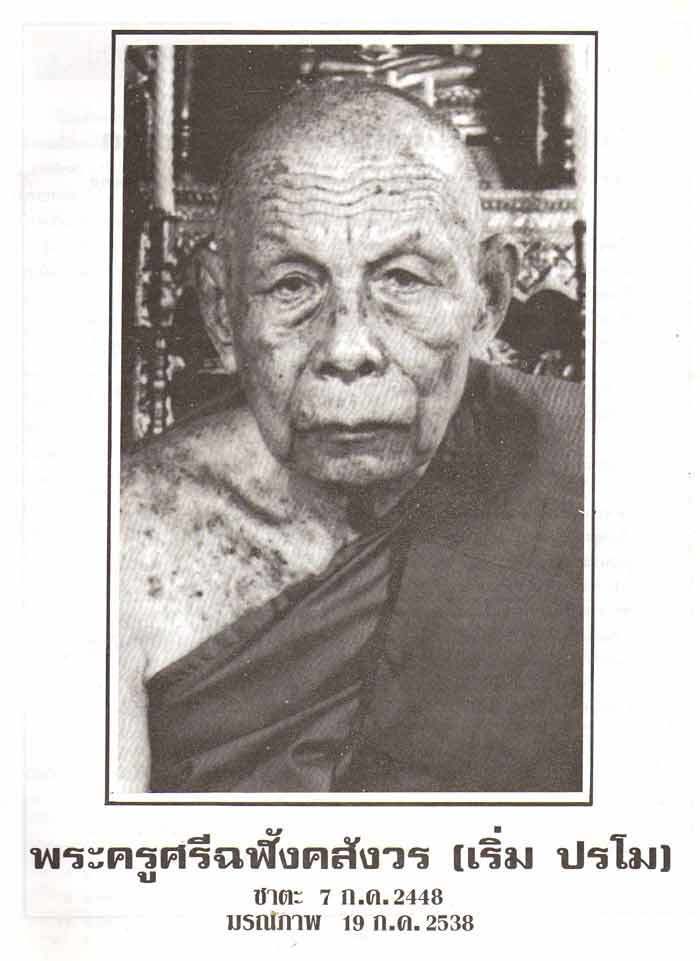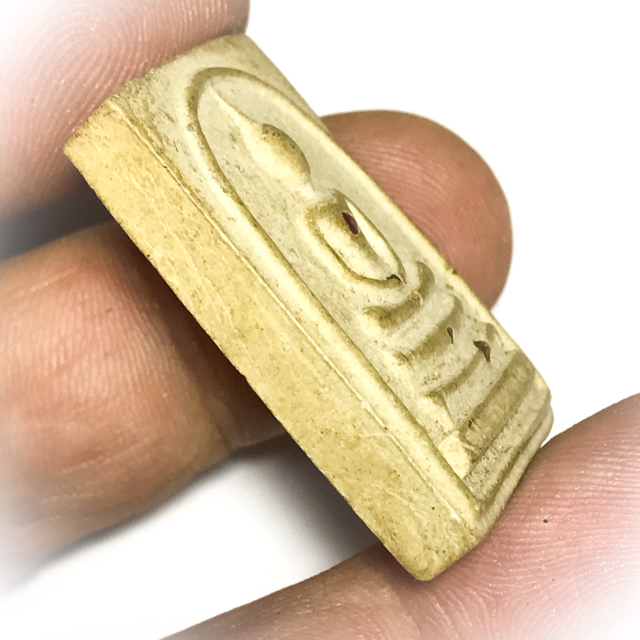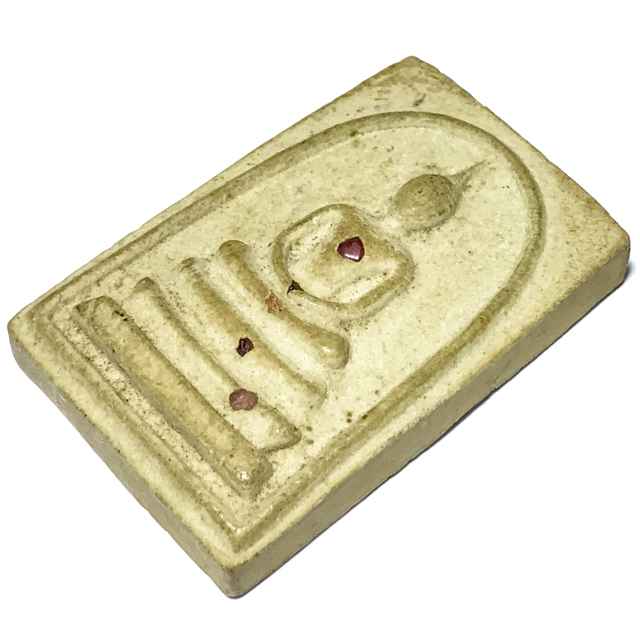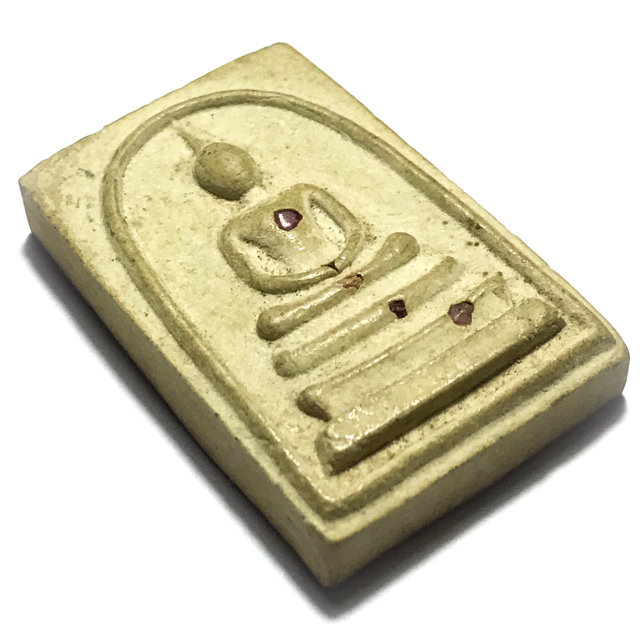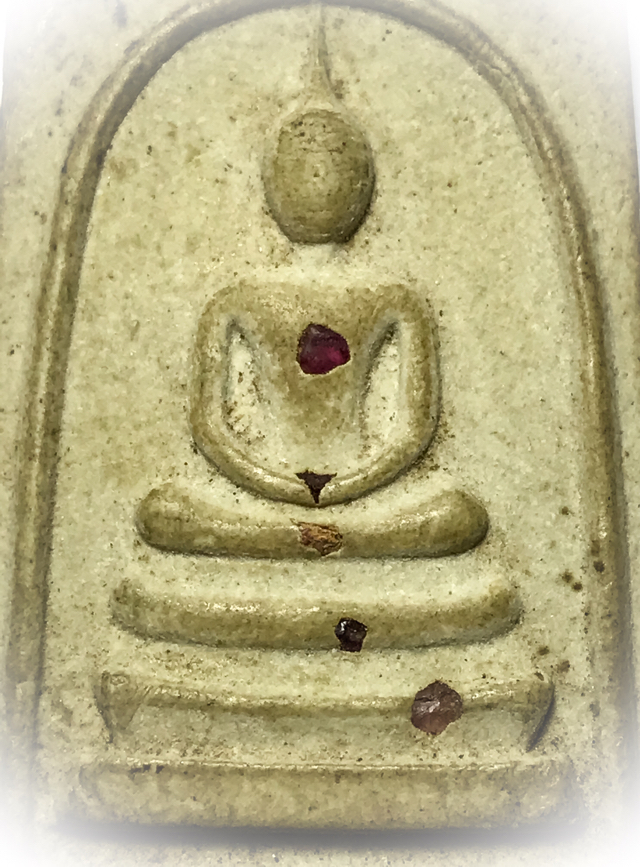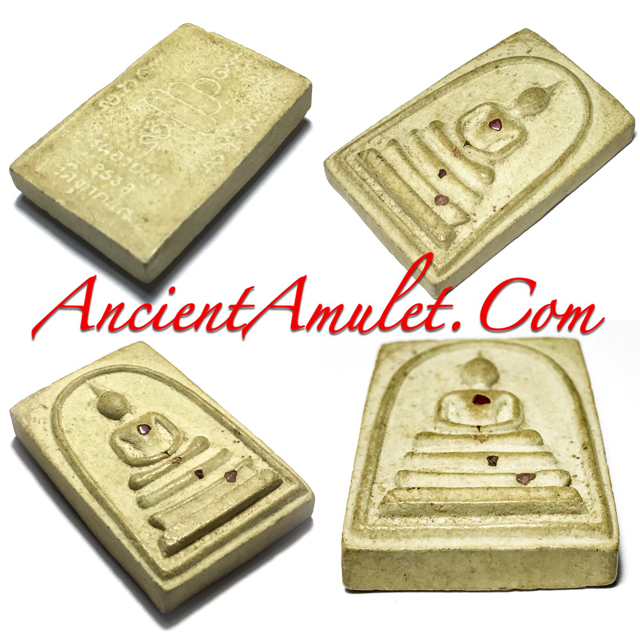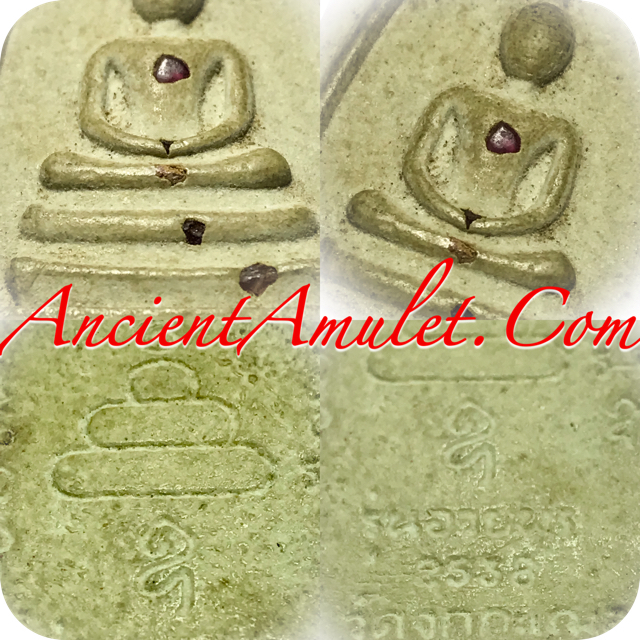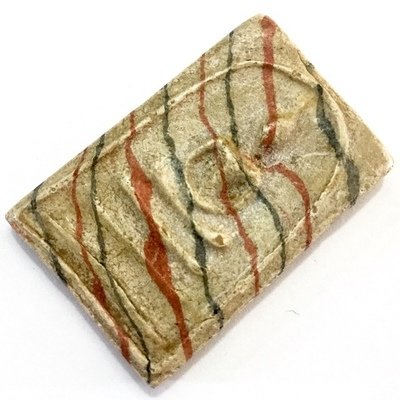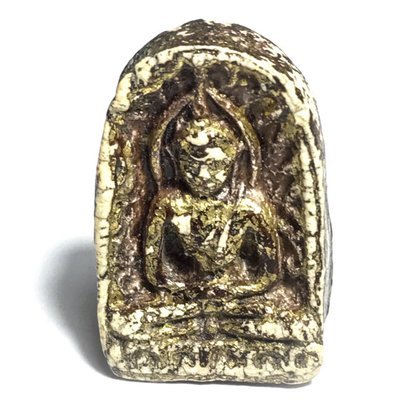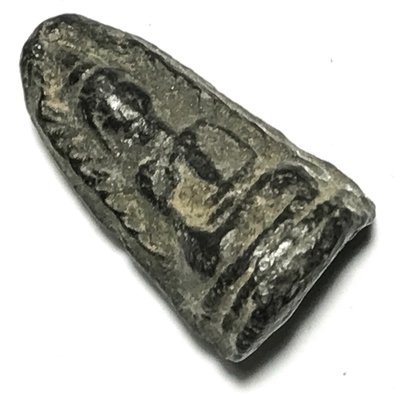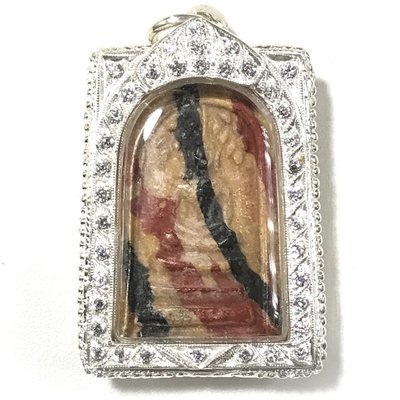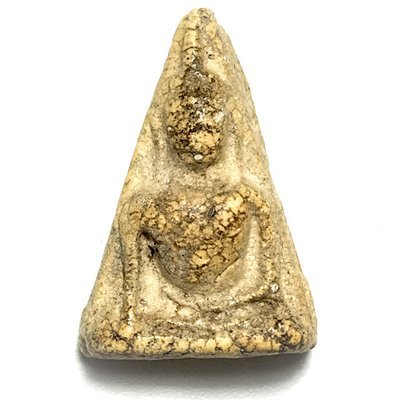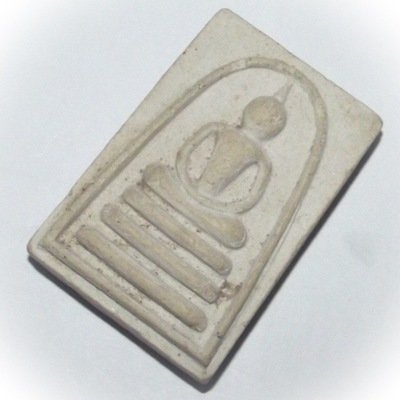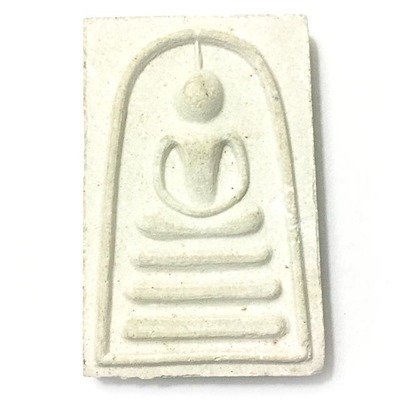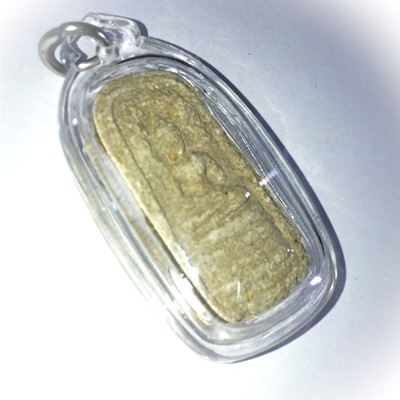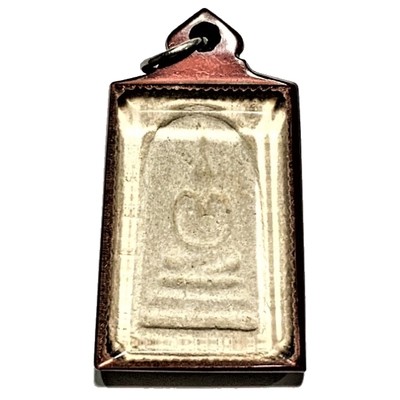Presenting a tiny but powerful and rare classic amulet from one of the Great Khao Or Masters of the 20th Century, Rian Glom Lek Hlang Chedi 2505 BE Nuea Tong Daeng Miniature Guru Monk Coin Por Tan Klai Wajasit
This Sacred amulet of the Great Khao Or Master of Nakorn Sri Tammarat, Master of Wat San Khan and Wat Pratat Noi, is a very rare amulet from Por Tan Klai’s 2505 BE Blessing Ceremony Edition, and is considered a ‘Jaek mae Krua’ type amulet (meaning ‘give to the kitchen maids and temple helpers’), which is suitable not only for men, but due to its miniature size, a perfect amulet for ladies or children to wear.

Rian Glom Lek 2505 BE Por Tan Klai Wajasit Wat Suan Khan
The 2505 BE edition of amulets of Por Tan Klai, is a highly preferred edition, which saw his famous ‘Rian Glom’ round Monk coin amulet with Chakra released, The Rian Glom Lek Hlang Chedi, and the Roop Tai Por Tan Klai Guru Monk Blesséd Photographamulets such as look om chan hmak and ya sen tobacco balls, and sacred powder amulets of various models.
A very rare and highly prized amulet for the devotees of Por Tan Klai to associate with his image and pray to him with a blessed image of the Guru, and the Chedi Relic Stupa on rear face for Buddhanussati and Marananussati. A powerful and Sacred amulet which has passed through the hands of the Guru and been blessed by him.
Por Tan Klai was one of the Top Guru Master Monks of the Last Century, and is considered one of the Four Great Masters of the Previous Generation of Lineage Masters of the Khao Or Southern Sorcery Lineage.
Kata Bucha Por Tan Klai
Pra Somdej Fang Ploi Run Uay Porn Hlang Yant 2538 BE - Gammagarn Model with Ruby Fragments Luang Por Rerm Wat Juk Gacher
Presenting a highly recommendable Sacred Amulet, the Pra Somdej Fang Ploi Pim Gammagarn amulet of the 2538 BE Uay Porn Edition of Luang Por Rerm, Wat Juk Gacher, in Sri Racha, Chonburi. The amulet is a Pim Gammagarn Masterpiece Model with real red Ruby Fragments inserted into the front face of the votive tablet.
The features of the Buddha Image are classic Pra Somdej. The Pim has a very clear cut and highly defined relief, which is raised up enough from the flat surface of the amulet to cast shadows below its protruding features, which allows for a high level of contrast when examining under the eye loupe in natural light. On the upper section of the rear face of the Votive Tablet, we can see the Yant Ongk Pra, with Khom Agkhara Kata 'Na Ma A U' are embossed on the rear face of the Votive Tablet, with three Unalome, one to crown the Ongk Pra, and one each for the Khom Agkhara syllables, with the letter "U" below to seal the spell.
The lower section of the rear face of the Pra Somdej is embossed with the name of the edition, Maker and Temple 'Run Uay Porn Luang Phu Rerm Wat Juk Gacher 2538 BE'
Luang Por Rerm was a Gaeji Ajarn Master Monk of the Chonburi Province, who despite the fact his amulets are of lesser price than many of his Peers, his reputation, as well as the power of his amulets, and their high demand, are in by no means lesser than that of the much more expensive alternatives, such as Luang Phu Tim (Wat Laharn Rai), and Luang Phu To (Wat Pradoo Chimplee). Luang Phu was however in his time, equally revered and respected as these other Great Masters. His amulets are considered to differ only in price, but not in power, to those of LP Tim and LP To.
Cosmic Power of Rubies;
The Rubies inserted into the Muan Sarn of of the amulet are 'Ploi Sek' enchanted gemstones, with special Magical Powers of Maha Pokasap to increase wealth, and even heal certain ailments. The Ruby is a stone of nobility, which captivates the eye, considered the most magnificent of all gems, the queen of stones and the stone of Emperors and Kings. The Ancients believed it surpassed all other precious stones in its virtues, and its value exceeded even that of the Diamond. The Chinese Emperor Kublai Khan was said to have offered an entire city in exchange for a sizable Ruby.
Rubies are Revered in many cultures throughout history, the Ruby has always been a talisman of passion, protection and prosperity. It symbolizes the sun, and its glowing hue suggests an inextinguishable flame within the stone that legends claim would shine through even the thickest clothing and could not be hidden; if Ruby were cast into water it would cause it to boil, and if carved and pressed into wax, it would melt the wax. It was worn as an amulet or charm to ward off plague and pestilence, warned its wearer of impending danger, kept the body safe, and banished sadness and foolish thoughts. It was reputed to bring its owner peace, drive away frightful dreams, restrain lust, and to help resolve disputes. Burmese legend declares inserting a Ruby into the flesh would make one completely invulnerable.
Magickal Properties
Maha Amnaj
Today, Ruby’s metaphysical properties are no less astounding. This exquisite crystal emanates the pure Red ray with a vibrancy unsurpassed in the mineral kingdom. It actively stimulates the Base Chakra, increasing vitality and chi, the life-force energy, throughout the physical body and into the spirit. It promotes a clear mind, increased concentration and motivation, and brings a sense of power to the wearer, a self-confidence and determination that overcomes timidity and propels one toward prosperity and achievement
Maha Sanaeh
Ruby initiates the sensual pleasures of life. It stirs the blood and stimulates the heart, encouraging one to enjoy being in the physical world. It increases desire and sexual energy, and may be used to activate the kundalini. Ruby has always been associated with love, especially faithful passionate commitment and closeness. In antiquity Rubies were considered to be perfect wedding stones. Ruby’s intense energy sharpens the mind, bringing a heightened awareness and excellent concentration. It promotes a courageous attitude, and may increase one’s success in controversies and disputes. - Source; Crystal Vaults .
Luang Por Rerm was one of the Great Chonburi Masters, whose Merits were many, and reached far afield, such as his payment and donation of the nine Look Nimit Arahant Balls for installation at the Temple of Wat Thai in Los Angeles, United States, in the year 2525 BE.
The name of the temple of Wat Juk Gacher, is also the only temple with this name in the country. This is because of an olden days folklore of a place in the forest in what is now known as Bang Lamung (Chonburi), there was a place where woodcutters and hunters and other people who lived in the forests would have some huts, which was known as 'Juk Gacher'. The word 'Gacher' comes from ancient Khmer, and means 'Tree'.
There is something about the temple of Wat Juk Gacher, that is told by the faithful devotees of Luang Por Rerm, which is indicative of Luang Por Rerm's great purity of practice as a Monk, which recodrs that all of the abbots who stayed at Wat Juk Gacher before Luang Por Rerm, disrobed and left the Sangha. It is said by believers, that only Luang Por Tong the original developer of the temple, Luang Por Khan and LP Rerm did not disrobe.
Only Luang Por Rerm and Luang Por Khan remained until their deaths at the temple. The reason is said to be that the temple was built in a very haunted and wild area of forest, and that only a monk who was able to keep a high practice of purity would be able to survive the temple without disrobing.
Luang Phu Rerm Bparamo was born in Sri Racha Municipality in Chonburi Province on Friday the 7th September 2448 BE. He was given the name 'Rerm' with the Family Surname of 'Chiang Aek'. His Father was called Mr. Ming Chiang Aek, and his Mother was called Mrs. Liam Chiang Aek. They were a large family, and Luang Phu Rerm had 1 brother and 9 sisters. Including the youong Master Rerm, there were 11 Siblings in all, who were 1. Master Rerm 2. Miss Tong Dee 3. Master Reun 4. Miss Thome 5. Miss Ob 6. Miss Samruay, 7. Miss Yian 8. Minss Hongs 9. Miss Hwaay 10. Miss Pheung and 11. Miss Tawee.
Luang Phu Rerm was always interested in practicing Dhamma and following the Buddhist Path since a very young age, and so when he reached the age of 20, he ordained as a Bhikkhu at Wat Ang Sila Temple with Pra Kroo Suntorn Tammaros as his Upachaya Ordaining Officer. Pra Ajarn Jua (Wat Ang Sila) was his Pra Gamawajajarn Prompting Officer, and Pra Ajarn Lamduan was his Pra Anusawanajarn Witness. Luang Phu rerm was given the Ordained Surname of 'Bparamo'.
After his ordination, Luang Phu Rerm went to stay at Wat Juk Gacher, during the time that Pra Atigarn Luang Por Khan was the residing abbot. The reason that Luang Phu Rerm did not ordain at Wat Juk Gacher directly, was because at that time, the temple of Wat Juk Gacher still did not have an Uposatha shrine room, so it was not possible to ordain monks there. Luang Phu Rerm began to study the Dhamma Vinaya diligently, and made great exertions to practice according to the Vinaya. The local Folk noticed his austerities and were filled with faith in his genuine practice.
Then, only 6 years after Luang Phu Rerm arrived to stay at Wat Juk Gacher, Luang Por Khan passed away, Leaving Wat Juk Gacher without an Abbot, to administrate and take care of the temple. So the local devotees immediately began to beseech Luang Phu Rerm to take on the task, which he accepted. One year later, the Sangha Comittee elected Luang Phu rerm to become the Bishop of the Municipality, in addition to being Abbot of Wat Juk Gacher.
This is incredible when one considers that Luang Phu Rerm was still only 6 years into his Ordained Life, and was not yet either a Thaera (decade or more ordained) not was he a 'Pra Kroo' (academically credited with degree). But his great selfless effort, and ability to administrate and get things done, was enough for his lack of academic degrees to be overlooked.
Administrative Trajectory Timeline
2479 BE - Luang Phu Rerm Officially became Abbot of Wat Juk Gacher
2484 - His status was promoted to Pra Gammawajarn
2485 BE - he attained Upachaya Status, hence able to Ordain Bhikkhus
2487 BE - Elected to be the Bishop of Beung - Nong Kham District
2518 BE - Elected to become the Vice-Bishop of Sri Racha Municipality
2519 BE - Elected Bishop of Sri Racha
2530 BE - Resigned as Abbot of Wat Juk Gacher, to accept the position of Abbot of the Royal Temple of Wat Judta Tis Dhamma Saparam Voraviharn in Si Chang, Chonburi, in response to the honor and respect given by the Sangha Comittee in offering him the position, and asking his help.
2481 BE Promoted to Pra Kroo Chan Pratuan
2493 BE - Awarded the Royal Eminent Status of Pra Kroo Sanyabadtr Jao Kana Tambon Chan Dtri Batchelor of Arts in Dhamma as Bishop of the Municipality
2507 BE - Awarded the Royal Eminent Academic Status of Pra Kroo Sanyabadtr Chan To Doctorate Degree in Dhamma and continued status as Bishop of the Municipal District
2515 BE- Awarded the Royal Eminent Academic Status of Pra Kroo Sanyabadtr Chan Aek Masters Degree in Dhamma and given status as Arch-Bishop of the Municipal District
2520 BE - Awarded the Royal Eminent Academic Status of Pra Kroo Sanyabadtr as Arch-Bishop of the Metropolitan and Municipal Districts
Luang Phu Rerm was endowed with Adept Mastery in Puttakom (Buddha Magic). Luang Phu rerm was always extremely interested in all forms of Buddha Magic and Sorcery since a young age, and since the day he ordained, he hurried to visit various Great Kroo Ba Ajarn to seek out the secrets of many powerful Wicha, and beseech permission to study and practice Wicha Akom under their tutelage.
Above; Luang Phu Rerm Bparamo (2448 BE - 2538 BE)
Luang Phu Rerm however tells that his first ever Kroo Ba Ajarn of all, was the great Luang Por Am, the old abbot of Wat Nong Grabork (Rayong). Luang Por Am was a great Master of Wicha Pae Maha Lap Lucky Goat magic, and his carved Goat animist charms were, and still are amongst the most highly sought after of all Masters. Luang Phu Rerm learned the Wicha Pae Maha Lap from Luang Por Am, and Mastered its powerful Metta Maha Lap spell.
Luang Por Am also bestowed various other Powerful Wicha to Luang Phu Rerm, including the Wicha See Pheung Jet Jantr 7 Moons Potion, the Wicha Fon Saen Ha Maha sanaeh Metta Spell. But Luang Por Am did not just simply bestow these Wicha on Luang Phu Rerm without testing him first, Before Luang Por Am decided to teach Luang Phu Rerm, he tested his Samatha Meditation and Kammathana abilities, by taking him to a forest cemetery in the dead of night, and binding his wrists with a cord, which he tied behind his back, and strapped to his neck.
He gave Luang Phu Rerm 4 Kata Incantations, and told him to sit there in the dark cemetery and perform the incantation until the noose and the hand bindings fell from his wrists and neck. Luang Phu Rerm was able to successfully perform the spell and release his fetters with Magick, and Luang Por Am fervently accepted him as his apprentice.
Apart from Luang Por Am, Luang Phu Rerm received Wicha from an number of other Great Masters of that Era, including; Wicha Palad Khik, and Wicha Hnaa Phaag Suea (Tiger forehead) from the Great Luang Por Ee of Wat Sattaheeb, Wicha Hnang Hnaa Phaag Suea from Luang Por Say of Wat Nong Gaet Noi, Wicha Tam Pong 12 Kasat (Sacred 12 Kings Powder making method), of Luang Por Tian, of Wat Bote (pathum Thani), and a host of other Wicha from many Masters, including Luang Por Ong of Wat Nong Ree, Luang Por Phuy of Wat Hnaa Pratat, and Jao Kun Sri, of Wat Ang Sila.
Luang Phu Rerm passed away silently after his almsround and eating without anyone noticing, passing away peacefully without letting anybody know or make a fuss over his passing, in the same year as this final edition in 2538 BE on the 19th July, at the age of 90 Years Old.
